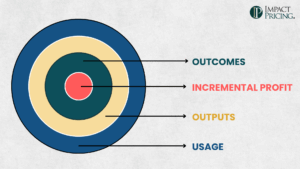You can listen to the full audio version of this blog we call — Blogcast.
Most companies set their pricing strategy early on and rarely revisit it, potentially missing opportunities for greater profitability and market alignment. Choosing the right pricing strategy is crucial, and what may have worked initially might not be the best fit as the business evolves. In this article, we explore the pros and cons of four popular pricing strategies — Value-Based Pricing, Competitor-Based Pricing, Cost-Plus Pricing, and Hourly Pricing — to help you determine which model best suits your business needs and maximizes your revenue potential.
Value-Based Pricing
Value-based pricing (VBP) means charge what your buyers are willing to pay. The price is set based on the perceived value of your product or service.
Pros
It’s impossible to price better than what a buyer is willing to pay. If you charge a little more, the buyer won’t buy. If you charge a little less, you leave money on the table.
When the company prices based on the value the buyer perceives, it focuses much more of the company on the buyer. You end up with better products, marketing, and sales performance.
Cons
It’s impossible to know how much any buyer is willing to pay. You can’t read your buyers’ minds. For this reason, I think of VBP as a goal or an attitude. You can never be perfect, but you can always get a little better.
VBP is also complex to implement. Who inside your company knows what a buyer is willing to pay? How do you operationalize that for different buyers? How do you change prices when market conditions change? These are challenging questions without easy answers.
VBP is not even possible when dealing with thousands or hundreds of thousands of products. It’s just not practical to examine each product and then analyze how much different customers would pay for it.
Competitor-Based Pricing
Competition-based pricing (CBP) is when a company bases its pricing on the prices of its competitors in the market.
Pros
CBP is much simpler to implement than VBP. You simply look at your competitors’ price, maybe add or subtract a little, and then call that your price.
In situations where there is little differentiation between your product and your competitor’s, this is a reasonable strategy. If your buyers see little difference, then price is the most important determining factor.
Another plus is that when your competitors raise prices, you do too. That adds profit to the industry, including your pocket. When it’s obvious everyone sets the same prices, competitors have much less incentive to compete on price.
Cons
Sometimes, it’s hard to find your competitors’ prices. If they don’t publish them, you only know what you hear from your salespeople, a dubious source. Assume your salespeople are telling you the truth, but the procurement people they are learning from probably aren’t.
Price segmentation is challenging. Assuming you have a somewhat differentiated product, you are missing out on some of the market. If there are two customer types, one that prefers your product and another that prefers your competitor’s product, then which customer type do you price for? Ideally, you would have a different price for each customer type.
Just like in the plusses, if a competitor lowers their price, you will too. This is likely to start a price war, a race to the bottom. There is no easier way to destroy profits in the entire industry than a price war. This is a risky strategy.
Finally, to implement CBP, you need to continually monitor your competitors’ prices. You must be able to change your prices when you see them change theirs.
Cost plus
Cost plus pricing is the most common pricing strategy for companies that make physical goods. They take the cost of building a product and then add a markup to that cost to get their price. For example, if it costs $10 to make something, and the company wants a 50% margin, they simply set the price at double the cost, or $20. Service companies companies often do something similar.
Pros
Cost plus pricing is simple and you don’t have to rely on information from outside your company.
This strategy ensures that you cover your costs and helps finance hit its margin goals. After all, you are pricing based on margin.
Buyers see this as fair. Somehow, shoppers (all of us) have been conditioned to believe that companies should set prices at some reasonable margin above their costs. Of course, the most successful companies price much higher than that. After all, the margin on a software product is huge.
Cons
This leaves a lot of money on the table. Costs don’t drive value, and costs don’t drive willingness to pay. Cost-plus pricing is completely devoid of market information. What if customers are willing to pay you a lot more? Shouldn’t you get it?
Cost plus pricing also has some very odd incentives. You are worse off as you become more efficient at manufacturing. Imagine you currently manufacture a product for $30 and sell it at a 50% margin, or $60. You make $30 of profit for each unit sold. Then, engineering figures out how to make the product at $20. You lower your price (really???) to $40 to keep that 50% margin, and now you only make $20 in profit per unit. Why would you ever lower costs?
Hourly
Hourly pricing is when service companies charge a set amount for each hour worked.
Pros
Since this is a lot like cost-plus pricing, but for services, the same pros apply. It’s simple, it covers your costs, and buyers seem to like it (until they learn differently).
Another pro is that you often don’t know how much time a project will take. Pricing by the hour puts the risk on the buyer. If the project takes longer than expected, the buyer pays more, and you still cover your costs.
Cons
The biggest reason to dislike cost-plus pricing is the mismatched incentives. The buyer wants a project to take fewer hours. The seller wants the project to take more hours. This adds unnecessary tension to the project.
The seller may take longer or add unnecessary steps because each hour worked means more revenue and profit to them. The buyer loses trust in the seller with each additional hour.
Keeping track of time spent is a wasted effort, and usually not accurate anyway. Most people who bill by the hour retroactively estimate the time spent at the end of a day, week, or month.
As you get better and more efficient, you can do the same job in less time, meaning you make less money for the same outcome. As you get better, you should be making more money for your expertise.
Hybrid
There isn’t a single ideal pricing strategy, but I lean toward always pursuing Value-Based Pricing and using the other strategies as necessary for simplicity.
For example, If you resell thousands of products, it’s very hard to use VBP on each one. However, you could start with a version of cost-plus, adding a standard markup to each one. Then, you could categorize the products based on how much buyers value them. The categories buyers value the most get a higher markup percentage.
As another example, for a low-differentiation product, you could start with competitor-based pricing. Then, watch for the types of customers or situations where you win more often and figure out why. That is likely a market segment to which you could charge a higher price. Even if your price goes up and down with your competitor’s price, the incremental price you charge above the competitors’ price could be higher for this segment.
If you offer a service and are asked to bid on a project in which you can’t predict the scope, it’s perfectly fine to quote an hourly rate for a few hours so you can better understand the problem the buyer wants to solve and the solution you can propose. During that investigation phase, you can also learn the solution’s value to the buyer. Then, after you know more, you can follow up with a fixed price proposal based on value.
Buyers trade money for value. Optimal pricing captures more of that value for you. This implies you can always do better when you add a bit more value-based pricing to whatever you’re doing.
Share your comments on the LinkedIn post.
Now, go make an impact!
 Tags: cost plus, price, pricing
Tags: cost plus, price, pricing













